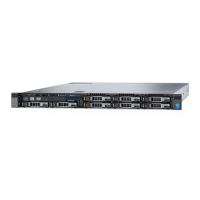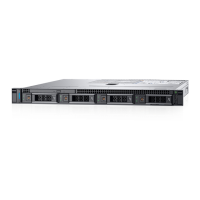Thermal and acoustics
The system's thermal management delivers high performance through optimized cooling of components at the lowest fan speeds
across a wide range of ambient temperatures from 10°C to 35°C (50°F to 95°F) and to extended ambient temperature ranges.
These optimizations result in lower fan power consumption which translate to lower system power and data center power
consumption.
Thermal design
The thermal design of the system reects the following:
• Optimized thermal design: The system layout is architected for optimum thermal design. System component placement and
layout are designed to provide maximum airow coverage to critical components with minimal expense of fan power.
• Comprehensive thermal management: The thermal control system regulates the system fan speeds based on feedback from
system component temperature sensors, as well as for system inventory and subsystem power draw. Temperature monitoring
includes components such as processors, DIMMs, chipset, system inlet air ambient, hard disk drives, NDC, and GPU.
• Open and closed loop fan speed control: Open loop fan control uses system conguration to determine fan speed based on
system inlet air temperature. Closed loop thermal control uses temperature feedback to dynamically adjust fan speeds based on
system activity and cooling requirements.
• User-congurable settings: With the understanding and realization that every customer has a unique set of circumstances or
expectations from the system, in this generation of servers, we have introduced limited user-congurable settings in the iDRAC9
BIOS setup screen. For more information, see the Dell EMC PowerEdge system Installation and Service Manual on Dell.com/
Support/Manuals and “Advanced Thermal Control: Optimizing across Environments and Power Goals” on Dell.com.
• Cooling redundancy: The system allows N+1 fan redundancy, allowing continuous operation with one fan failure in the system.
• Environmental Specications: The optimized thermal management makes the R940xa reliable under a wide range of operating
environments.
Expanded operating temperature restrictions
• The operating temperature is for a maximum altitude of 950 m for fresh air cooling
• No cold start-ups below 5°C due to hard drive constraints
• Apache Pass DIMM, NVDIMM, PCIeSSD and NVME are not supported
• GPGPU conguration are not supported
• LRDIMM > 32 GB are not supported in x4 socket congurations
• Redundant power supply units are required
• Non Dell qualied peripheral cards and /or peripheral cards greater than 25 W are not supported
Acoustical design
The acoustical design of the PowerEdge R940xa reect the following:
• Versatility: The R940xa save you power draw in the data center but are also quiet enough for oce environment in typical and
minimum congurations. You may nd that the system is suciently quiet where the sound it emits blends into the environment .
• Adherence to Dell EMC's high sound quality standards: Sound quality is dierent from sound power level and sound pressure
level in that it describes how humans respond to annoyances in sound, like whistles and hums. One of the sound quality metrics
in the Dell EMC specication is prominence ratio of a tone.
• Noise ramp and descent at boot-up from power o: Fan speeds and noise levels ramp during the boot process (from power- o
to power- on) in order to add a layer of protection for component cooling in the event that the system were not to boot properly.
In order to keep the boot-up process as quiet as possible, the fan speed reached during boot-up is limited to about half of full
speed.
• Noise level dependencies: If acoustics is important to you, several conguration choices and settings are important to consider:
– For lower acoustical output, use a small number of lower rotational- speed SATA hard drives, nearline SAS hard drives, or
non- rotational devices like SSDs. 15k hard drives generate more acoustic noise than that of lower rotational- speed hard
drives, and noise increases with number of hard drives.
32

